Dissertation: Employee Motivation and Performance at Tesco PLC
VerifiedAdded on 2020/06/04
|47
|13858
|143
Thesis and Dissertation
AI Summary
This dissertation investigates the impact of employee motivation on staff performance at Tesco PLC, a major British multinational retailer. The study, based on a survey of 15 managers, explores various motivational factors such as recognition, empowerment, and growth opportunities. It examines the use of monetary and non-monetary rewards and recommends a mixed reward system to boost employee engagement and productivity. The research also emphasizes the importance of delegation, family health, and educational insurance to minimize staff turnover and achieve business goals. The dissertation includes an introduction, literature review, research methodology, data analysis, and a conclusion with recommendations for Tesco PLC and future research in the field of employee motivation. The study highlights the crucial role of human resources in achieving organizational objectives and maintaining a competitive edge in the retail industry.
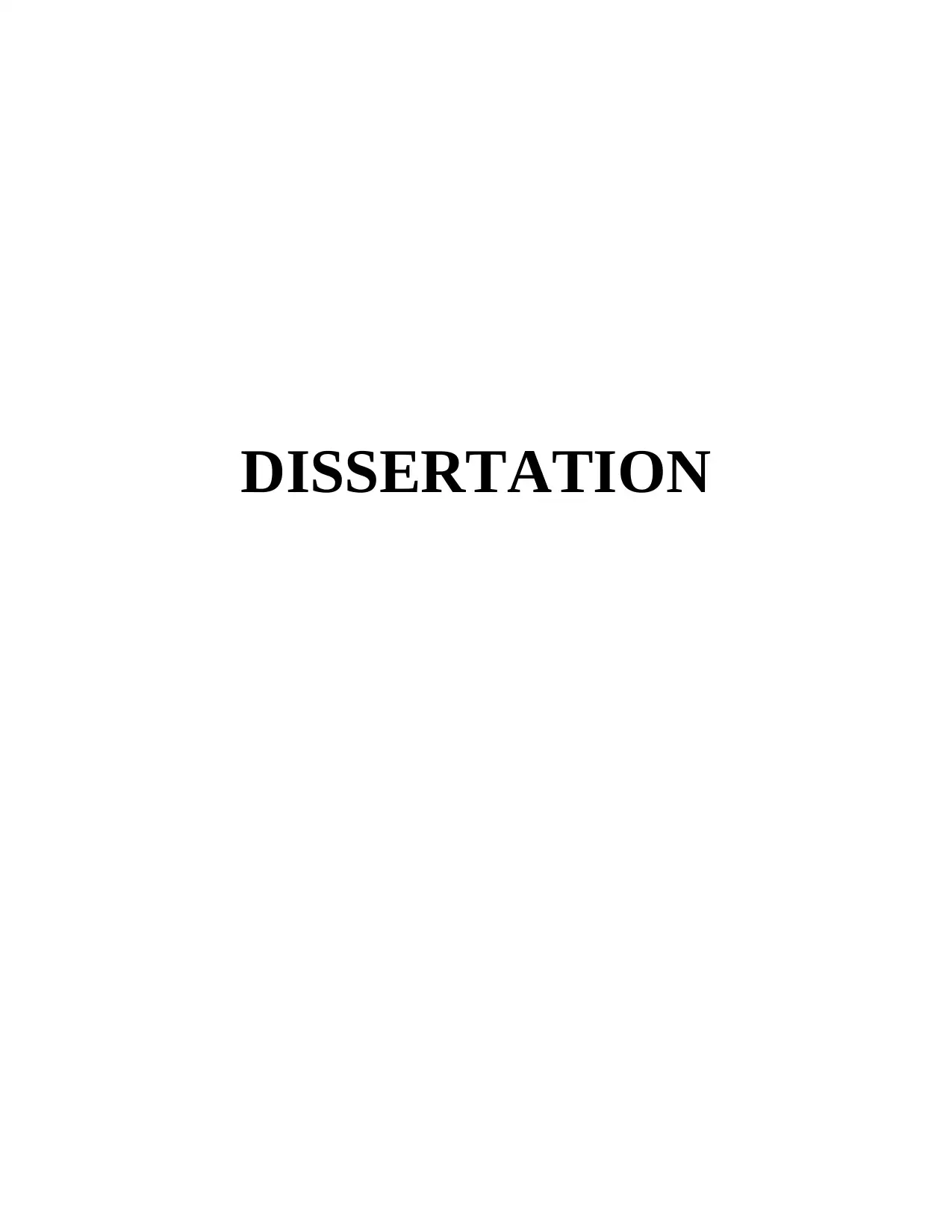
DISSERTATION
Paraphrase This Document
Need a fresh take? Get an instant paraphrase of this document with our AI Paraphraser

Acknowledgement
I would like to thank my research supervisor, friends and family members too because
without their considerable assistance, it would not be possible to complete the entire research
successfully and thoroughly. Thus, their coherent support, advice and suggestions make it
possible for me to accomplish the aim of the study.
I would like to thank my research supervisor, friends and family members too because
without their considerable assistance, it would not be possible to complete the entire research
successfully and thoroughly. Thus, their coherent support, advice and suggestions make it
possible for me to accomplish the aim of the study.

Executive summary
Human resources are an important asset of the company by which firm can attain its
determined objective. In every functional department of the company like marketing,
administration, finance, operation etc have required high skilled and talented personnel’s. Thus,
it can be said that employees are very essential asset for the company by which it can improve its
performance and productivity. Therefore, it is great responsibility of the firm to keep motivates
their workforce so as to meet the desired goals. Tesco PLC is a British multinational grocery and
general merchandise retailer which headquarters situated in the England United Kingdom. This
research investigated the role of employee motivation on the staff productivity on Tesco through
conducting a survey of 15 managers via questionnaire. The results of the research founded that
Tesco considered number of factors as a motivator such as hard work appreciation and praise by
the seniors, a sense of accomplishment and achievement, empowerment, more responsibility,
growth opportunity and advancement & a allocating challenging work also. It uses both the
monetary i.e. basic pay, appraisal, increment etc. and non-monetary rewarding tools i.e. free
shares, save as you earn scheme, pension scheme, discount cards, healthcare benefits, gym and
club membership, free phone facility and holiday discounts to empower their workforce so as to
maximize productivity. The results of the survey suggested the company to design a mixed
reward mechanism incorporating both monetary and non-monetary tools to motivate the people.
Moreover, firm has been recommended to use reward of delegation and provides family health &
educational insurance so as to boost motivation which in turn minimize staff turnover and enable
firm to accomplish business goals.
Human resources are an important asset of the company by which firm can attain its
determined objective. In every functional department of the company like marketing,
administration, finance, operation etc have required high skilled and talented personnel’s. Thus,
it can be said that employees are very essential asset for the company by which it can improve its
performance and productivity. Therefore, it is great responsibility of the firm to keep motivates
their workforce so as to meet the desired goals. Tesco PLC is a British multinational grocery and
general merchandise retailer which headquarters situated in the England United Kingdom. This
research investigated the role of employee motivation on the staff productivity on Tesco through
conducting a survey of 15 managers via questionnaire. The results of the research founded that
Tesco considered number of factors as a motivator such as hard work appreciation and praise by
the seniors, a sense of accomplishment and achievement, empowerment, more responsibility,
growth opportunity and advancement & a allocating challenging work also. It uses both the
monetary i.e. basic pay, appraisal, increment etc. and non-monetary rewarding tools i.e. free
shares, save as you earn scheme, pension scheme, discount cards, healthcare benefits, gym and
club membership, free phone facility and holiday discounts to empower their workforce so as to
maximize productivity. The results of the survey suggested the company to design a mixed
reward mechanism incorporating both monetary and non-monetary tools to motivate the people.
Moreover, firm has been recommended to use reward of delegation and provides family health &
educational insurance so as to boost motivation which in turn minimize staff turnover and enable
firm to accomplish business goals.
⊘ This is a preview!⊘
Do you want full access?
Subscribe today to unlock all pages.

Trusted by 1+ million students worldwide

TABLE OF CONTENTS
CHAPTER – 1 INTRODUCTION..................................................................................................1
Background of the study.........................................................................................................1
Research Aims and Objective................................................................................................2
Research questions.................................................................................................................3
Rationale of the study.............................................................................................................3
Significance of the study........................................................................................................3
Chapter structure....................................................................................................................4
CHAPTER – 2 LITERATURE REVIEW.......................................................................................5
Meaning and concept of employees motivation.....................................................................5
Factor which affect the employees motivation.......................................................................7
Tools and Techniques of bring motivation within workforce................................................8
Analyse the impact of motivation on the job performance..................................................11
CHAPTER -3 RESEARCH METHODOLOGY...........................................................................12
Introduction..........................................................................................................................12
Research philosophy-...........................................................................................................12
Research approach-..............................................................................................................13
Data collection-....................................................................................................................13
Data analysis-......................................................................................................................14s
Sampling...............................................................................................................................14
CHAPTER -4 DATA ANALYSIS AND INTERPRETATION...................................................16
Introduction..........................................................................................................................16
Thematic Analysis................................................................................................................16
CHAPTER -5 CONCLUSION AND RECOMMENDATION.....................................................32
Conclusion............................................................................................................................32
Recommendation..................................................................................................................33
Recommendation for future research...................................................................................34
REFERENCES..............................................................................................................................36
APPENDIX....................................................................................................................................41
Appendix 1: Research Questionnaire...................................................................................41
CHAPTER – 1 INTRODUCTION..................................................................................................1
Background of the study.........................................................................................................1
Research Aims and Objective................................................................................................2
Research questions.................................................................................................................3
Rationale of the study.............................................................................................................3
Significance of the study........................................................................................................3
Chapter structure....................................................................................................................4
CHAPTER – 2 LITERATURE REVIEW.......................................................................................5
Meaning and concept of employees motivation.....................................................................5
Factor which affect the employees motivation.......................................................................7
Tools and Techniques of bring motivation within workforce................................................8
Analyse the impact of motivation on the job performance..................................................11
CHAPTER -3 RESEARCH METHODOLOGY...........................................................................12
Introduction..........................................................................................................................12
Research philosophy-...........................................................................................................12
Research approach-..............................................................................................................13
Data collection-....................................................................................................................13
Data analysis-......................................................................................................................14s
Sampling...............................................................................................................................14
CHAPTER -4 DATA ANALYSIS AND INTERPRETATION...................................................16
Introduction..........................................................................................................................16
Thematic Analysis................................................................................................................16
CHAPTER -5 CONCLUSION AND RECOMMENDATION.....................................................32
Conclusion............................................................................................................................32
Recommendation..................................................................................................................33
Recommendation for future research...................................................................................34
REFERENCES..............................................................................................................................36
APPENDIX....................................................................................................................................41
Appendix 1: Research Questionnaire...................................................................................41
Paraphrase This Document
Need a fresh take? Get an instant paraphrase of this document with our AI Paraphraser


CHAPTER – 1 INTRODUCTION
Title: To analyze the impact of motivation on staff performance on the business, a case study of
Tesco Store Plc
Background of the study
In every business organisation, human resource plays a very crucial role as they
contribute their handwork in the business success and growth. In the absence of employees, no
business entity can operate and survive its business activities and function. Human resources are
that resource and asset of the company by which firm can attain its determined objective. In
every functional department of the company like marketing, administration, finance, operation
etc have required high skilled and talented personnel’s. Thus, it can be said that employees are
very essential asset for the company by which it can improve its performance and productivity.
Therefore, it is great responsibility of the firm to keep motivates and manages in an effective
manner. Company should keep maintain its personnel’s so as effectively carry out its business
activities. In addition to this, management should understand the actual needs and wants of the
employees which is related to the working condition, salary, employment, incentive, business
policies and practices. Firm should understand the issue of employees and make several
strategies to overcome this. In order to maintain and manage the employees, firm should develop
such impressive strategies and take several actions which is favourable and profitable for
employees as well as organisation. Motivation is one of the best way by which they can
encourage for higher performance and productivity. It is a process under which organisation’s
higher management encourages, inspire, appreciate, and recognise personnel’s for their effective
performance (Paharia, 2013). In this aspect, organisation observes and analyse the employee's
performance and appreciate them in terms of monetary and non monetary rewards. In a simple
word it can be said that motivation refers to the process by which higher authority provides the
encouragement, recognition, appreciation to the employees and its value is determined in terms
of money. In other word it can be said that internal and external factor that stimulate desire and
energy in employees to be continually interested and committed to a job, role, subject or to make
an effort to attain the objective.
Motivation is an essential way to retain and maintain human resource in the company. By
this way, management can able to gain the effective profitability and productivity by improving
the performance of employees. In an organisation employee’s motivation is very significant by
1
Title: To analyze the impact of motivation on staff performance on the business, a case study of
Tesco Store Plc
Background of the study
In every business organisation, human resource plays a very crucial role as they
contribute their handwork in the business success and growth. In the absence of employees, no
business entity can operate and survive its business activities and function. Human resources are
that resource and asset of the company by which firm can attain its determined objective. In
every functional department of the company like marketing, administration, finance, operation
etc have required high skilled and talented personnel’s. Thus, it can be said that employees are
very essential asset for the company by which it can improve its performance and productivity.
Therefore, it is great responsibility of the firm to keep motivates and manages in an effective
manner. Company should keep maintain its personnel’s so as effectively carry out its business
activities. In addition to this, management should understand the actual needs and wants of the
employees which is related to the working condition, salary, employment, incentive, business
policies and practices. Firm should understand the issue of employees and make several
strategies to overcome this. In order to maintain and manage the employees, firm should develop
such impressive strategies and take several actions which is favourable and profitable for
employees as well as organisation. Motivation is one of the best way by which they can
encourage for higher performance and productivity. It is a process under which organisation’s
higher management encourages, inspire, appreciate, and recognise personnel’s for their effective
performance (Paharia, 2013). In this aspect, organisation observes and analyse the employee's
performance and appreciate them in terms of monetary and non monetary rewards. In a simple
word it can be said that motivation refers to the process by which higher authority provides the
encouragement, recognition, appreciation to the employees and its value is determined in terms
of money. In other word it can be said that internal and external factor that stimulate desire and
energy in employees to be continually interested and committed to a job, role, subject or to make
an effort to attain the objective.
Motivation is an essential way to retain and maintain human resource in the company. By
this way, management can able to gain the effective profitability and productivity by improving
the performance of employees. In an organisation employee’s motivation is very significant by
1
⊘ This is a preview!⊘
Do you want full access?
Subscribe today to unlock all pages.

Trusted by 1+ million students worldwide

which corporation can able to develop its own brand image in the market (Patino and et.al.,
2016). As by excellent motivation techniques, employees improves their performance then
business performance can automatically improve. Motivation can be divided by two theories that
is intrinsic and extrinsic. In the context of intrinsic motivation, it is self desire to seek out new
things and new challenges for observe and assess individual capacity. On the other hand in the
extrinsic motivation. It is a performance of an activity in order to attain a desired outcome and it
is the opposite of intrinsic motivation. This mentioned aspect assist to the company in improving
the overall performance of business as well as employees. The following dissertation have main
aim is to analyse the impact of motivation on the job performance of employees with respect of
Tesco PLC. It is a British multinational grocery and general merchandise retailer which
headquarters situated in the England United Kingdom. As per the research it has been founded
that cited venture is the third largest retailer in the world according to the revenue and
profitability. It has 476000 numbers of employees whose gives their best contribution in the
attainment of business objective. Its major objective is to deliver the high quality of product and
services to the customer and gain large profitability. However, cited venture is faced the issue
related to the employees turnover through which company entire performance and profitability is
negatively affected (Pilbeam and Corbridge, 2010). The major reason behind the employee’s
turnover is lack of motivation among the human resource. Thus, it is very important for the
Tesco Plc to understand the concept of employee’s motivation and its impact on the personnel's
performance. Hence, the following dissertation have main aim is to assess the impact of
motivation on the employee's performance. For this aim, researcher has used various methods of
the research methodology like research approach, research design, research philosophy, data
collection, sampling etc. With assistance of these all method, investigator can obtain an
appropriate outcome of the investigation. In this present dissertation, researcher have conduct the
survey of 20 managers of the Tesco Plc to assess the impact of motivation on the employee's
performance. At the end of dissertation, researcher has concluded the result by analysed
collected information in the survey.
Research Aims and Objective
Research Aim and Objective of this study are as follows-
Aims
2
2016). As by excellent motivation techniques, employees improves their performance then
business performance can automatically improve. Motivation can be divided by two theories that
is intrinsic and extrinsic. In the context of intrinsic motivation, it is self desire to seek out new
things and new challenges for observe and assess individual capacity. On the other hand in the
extrinsic motivation. It is a performance of an activity in order to attain a desired outcome and it
is the opposite of intrinsic motivation. This mentioned aspect assist to the company in improving
the overall performance of business as well as employees. The following dissertation have main
aim is to analyse the impact of motivation on the job performance of employees with respect of
Tesco PLC. It is a British multinational grocery and general merchandise retailer which
headquarters situated in the England United Kingdom. As per the research it has been founded
that cited venture is the third largest retailer in the world according to the revenue and
profitability. It has 476000 numbers of employees whose gives their best contribution in the
attainment of business objective. Its major objective is to deliver the high quality of product and
services to the customer and gain large profitability. However, cited venture is faced the issue
related to the employees turnover through which company entire performance and profitability is
negatively affected (Pilbeam and Corbridge, 2010). The major reason behind the employee’s
turnover is lack of motivation among the human resource. Thus, it is very important for the
Tesco Plc to understand the concept of employee’s motivation and its impact on the personnel's
performance. Hence, the following dissertation have main aim is to assess the impact of
motivation on the employee's performance. For this aim, researcher has used various methods of
the research methodology like research approach, research design, research philosophy, data
collection, sampling etc. With assistance of these all method, investigator can obtain an
appropriate outcome of the investigation. In this present dissertation, researcher have conduct the
survey of 20 managers of the Tesco Plc to assess the impact of motivation on the employee's
performance. At the end of dissertation, researcher has concluded the result by analysed
collected information in the survey.
Research Aims and Objective
Research Aim and Objective of this study are as follows-
Aims
2
Paraphrase This Document
Need a fresh take? Get an instant paraphrase of this document with our AI Paraphraser

To analyse the impact of motivation on the employee’s job performance: A case study of Tesco
Plc
Objective
To understand the meaning and concept of employees motivation
To assess various tools and techniques for bring employees motivation in the company
To explore the factors which affect employees motivation
To determine the impact of employees motivation on the job performance
To recommend the strategies by which employees motivation can improve
Research questions
1. What is the concept of employee motivation and why it is necessary for the company?
2. Which tools and techniques are available to the Tesco for motivating their workforce?
3. What are the factors which influence employee motivation?
4. How staff motivation impacts their productivity and performance?
5. What strategies do Tesco must follow and implement so as to maximize workers
motivational level?
Rationale of the study
Employee’s motivation is considered as the most significant aspect behind success of the
organisation. It assists in improving the work performance of employees and company
profitability. In the absence of effective employee's motivation, company cannot carry out its
smooth functioning. Thus, it is very important for the corporation to use some techniques for
employee’s motivation through which they can enhance their quality and efficiency of working
at workplace. The major reason for selecting this topic as dissertation topic is that investigator
has detailed information about this topic. In addition to this, investigator has huge interest and
curiosity to know more about this mentioned aspect (Mathis and Jackson, 2011). Furthermore,
Tesco Plc is facing the issues related to employee’s turnover so in order to overcome this
problem, investigator has chosen this topic as dissertation topic.
Significance of the study
In the entire dissertation, researcher has faced the several, issues related to the time and
financial resource. With assistance of this study, investigator will gain an appropriate solution of
the study. As if company fails to meet the dead line then it because very difficult to met the
expectation of the clients and also it can create the negative harm to the organisation. By doing
3
Plc
Objective
To understand the meaning and concept of employees motivation
To assess various tools and techniques for bring employees motivation in the company
To explore the factors which affect employees motivation
To determine the impact of employees motivation on the job performance
To recommend the strategies by which employees motivation can improve
Research questions
1. What is the concept of employee motivation and why it is necessary for the company?
2. Which tools and techniques are available to the Tesco for motivating their workforce?
3. What are the factors which influence employee motivation?
4. How staff motivation impacts their productivity and performance?
5. What strategies do Tesco must follow and implement so as to maximize workers
motivational level?
Rationale of the study
Employee’s motivation is considered as the most significant aspect behind success of the
organisation. It assists in improving the work performance of employees and company
profitability. In the absence of effective employee's motivation, company cannot carry out its
smooth functioning. Thus, it is very important for the corporation to use some techniques for
employee’s motivation through which they can enhance their quality and efficiency of working
at workplace. The major reason for selecting this topic as dissertation topic is that investigator
has detailed information about this topic. In addition to this, investigator has huge interest and
curiosity to know more about this mentioned aspect (Mathis and Jackson, 2011). Furthermore,
Tesco Plc is facing the issues related to employee’s turnover so in order to overcome this
problem, investigator has chosen this topic as dissertation topic.
Significance of the study
In the entire dissertation, researcher has faced the several, issues related to the time and
financial resource. With assistance of this study, investigator will gain an appropriate solution of
the study. As if company fails to meet the dead line then it because very difficult to met the
expectation of the clients and also it can create the negative harm to the organisation. By doing
3
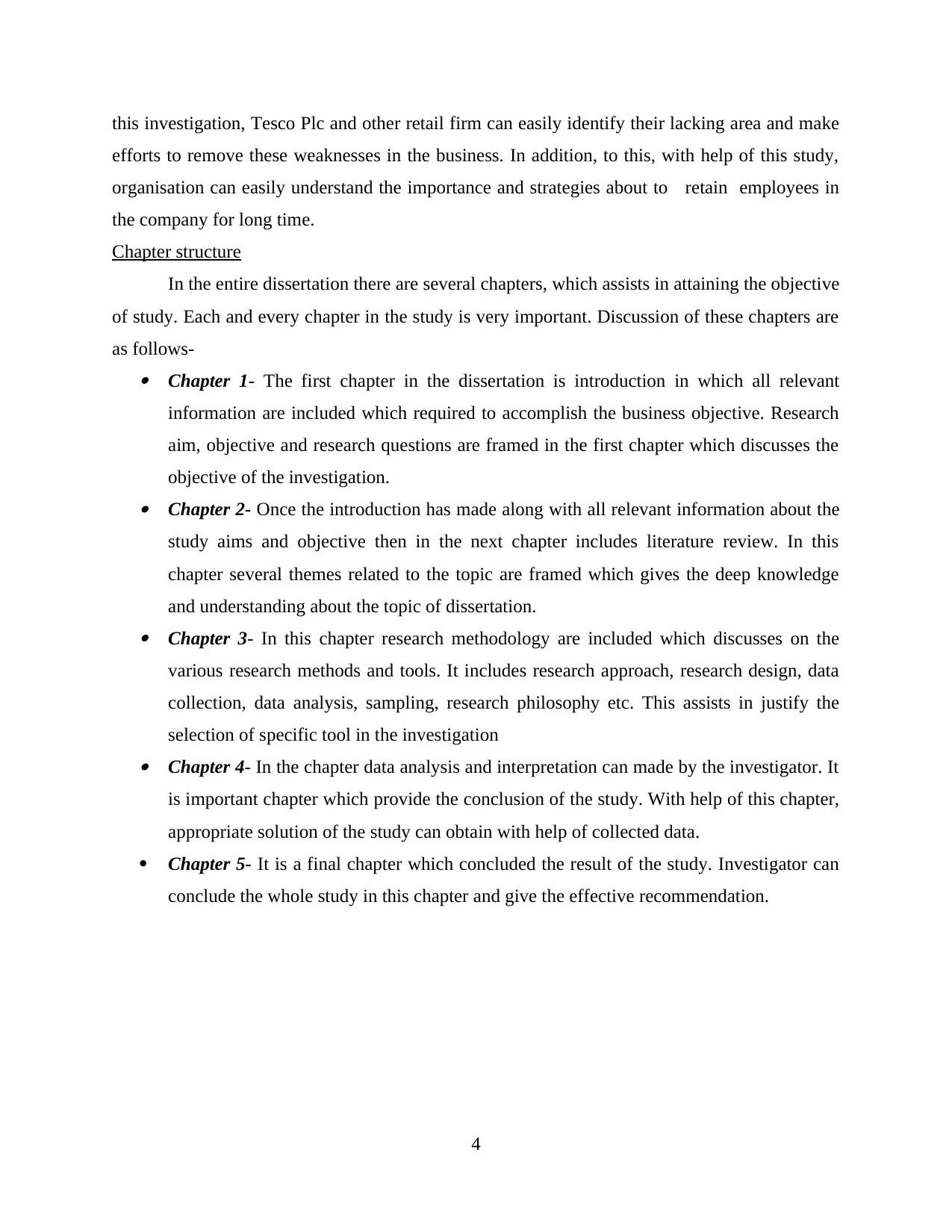
this investigation, Tesco Plc and other retail firm can easily identify their lacking area and make
efforts to remove these weaknesses in the business. In addition, to this, with help of this study,
organisation can easily understand the importance and strategies about to retain employees in
the company for long time.
Chapter structure
In the entire dissertation there are several chapters, which assists in attaining the objective
of study. Each and every chapter in the study is very important. Discussion of these chapters are
as follows- Chapter 1- The first chapter in the dissertation is introduction in which all relevant
information are included which required to accomplish the business objective. Research
aim, objective and research questions are framed in the first chapter which discusses the
objective of the investigation. Chapter 2- Once the introduction has made along with all relevant information about the
study aims and objective then in the next chapter includes literature review. In this
chapter several themes related to the topic are framed which gives the deep knowledge
and understanding about the topic of dissertation. Chapter 3- In this chapter research methodology are included which discusses on the
various research methods and tools. It includes research approach, research design, data
collection, data analysis, sampling, research philosophy etc. This assists in justify the
selection of specific tool in the investigation Chapter 4- In the chapter data analysis and interpretation can made by the investigator. It
is important chapter which provide the conclusion of the study. With help of this chapter,
appropriate solution of the study can obtain with help of collected data.
Chapter 5- It is a final chapter which concluded the result of the study. Investigator can
conclude the whole study in this chapter and give the effective recommendation.
4
efforts to remove these weaknesses in the business. In addition, to this, with help of this study,
organisation can easily understand the importance and strategies about to retain employees in
the company for long time.
Chapter structure
In the entire dissertation there are several chapters, which assists in attaining the objective
of study. Each and every chapter in the study is very important. Discussion of these chapters are
as follows- Chapter 1- The first chapter in the dissertation is introduction in which all relevant
information are included which required to accomplish the business objective. Research
aim, objective and research questions are framed in the first chapter which discusses the
objective of the investigation. Chapter 2- Once the introduction has made along with all relevant information about the
study aims and objective then in the next chapter includes literature review. In this
chapter several themes related to the topic are framed which gives the deep knowledge
and understanding about the topic of dissertation. Chapter 3- In this chapter research methodology are included which discusses on the
various research methods and tools. It includes research approach, research design, data
collection, data analysis, sampling, research philosophy etc. This assists in justify the
selection of specific tool in the investigation Chapter 4- In the chapter data analysis and interpretation can made by the investigator. It
is important chapter which provide the conclusion of the study. With help of this chapter,
appropriate solution of the study can obtain with help of collected data.
Chapter 5- It is a final chapter which concluded the result of the study. Investigator can
conclude the whole study in this chapter and give the effective recommendation.
4
⊘ This is a preview!⊘
Do you want full access?
Subscribe today to unlock all pages.

Trusted by 1+ million students worldwide
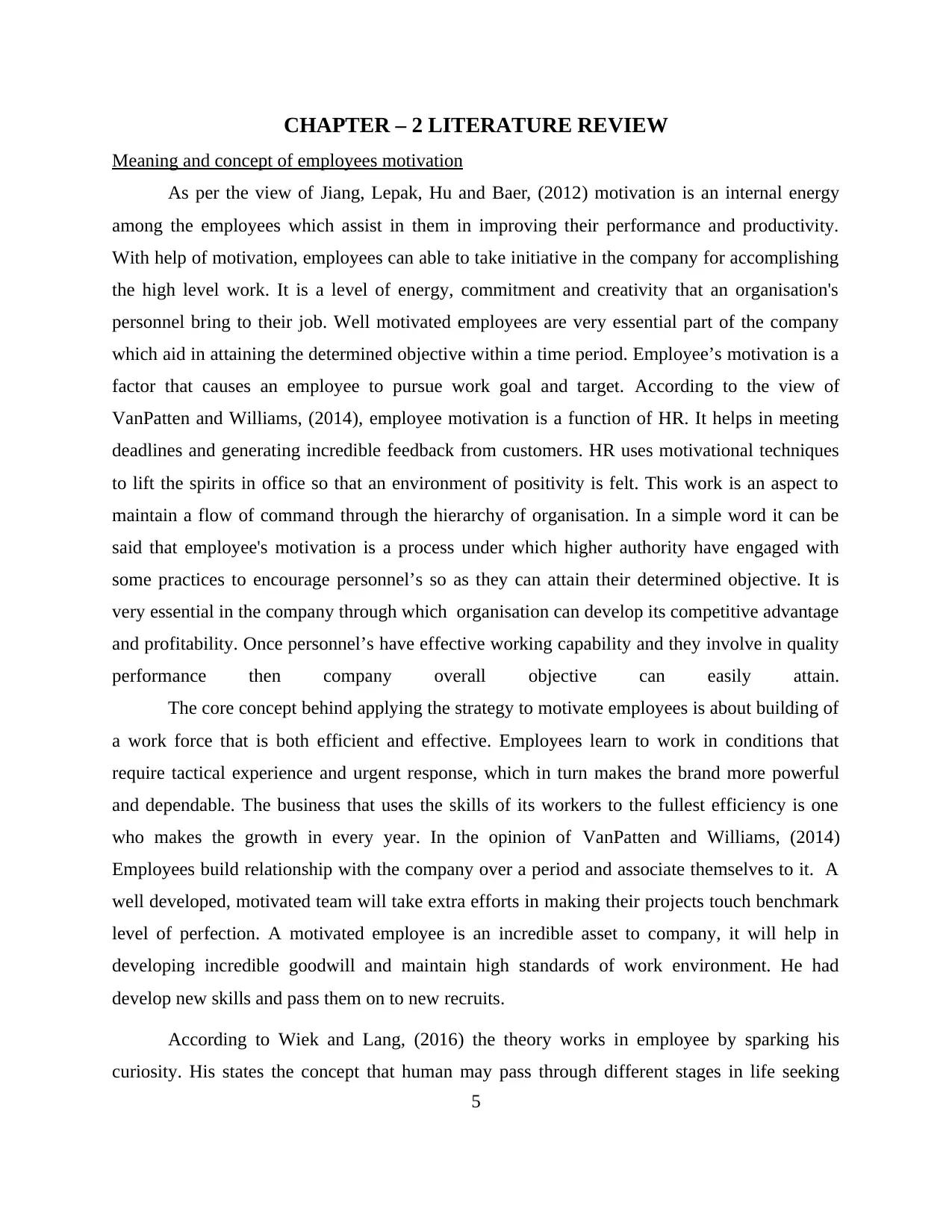
CHAPTER – 2 LITERATURE REVIEW
Meaning and concept of employees motivation
As per the view of Jiang, Lepak, Hu and Baer, (2012) motivation is an internal energy
among the employees which assist in them in improving their performance and productivity.
With help of motivation, employees can able to take initiative in the company for accomplishing
the high level work. It is a level of energy, commitment and creativity that an organisation's
personnel bring to their job. Well motivated employees are very essential part of the company
which aid in attaining the determined objective within a time period. Employee’s motivation is a
factor that causes an employee to pursue work goal and target. According to the view of
VanPatten and Williams, (2014), employee motivation is a function of HR. It helps in meeting
deadlines and generating incredible feedback from customers. HR uses motivational techniques
to lift the spirits in office so that an environment of positivity is felt. This work is an aspect to
maintain a flow of command through the hierarchy of organisation. In a simple word it can be
said that employee's motivation is a process under which higher authority have engaged with
some practices to encourage personnel’s so as they can attain their determined objective. It is
very essential in the company through which organisation can develop its competitive advantage
and profitability. Once personnel’s have effective working capability and they involve in quality
performance then company overall objective can easily attain.
The core concept behind applying the strategy to motivate employees is about building of
a work force that is both efficient and effective. Employees learn to work in conditions that
require tactical experience and urgent response, which in turn makes the brand more powerful
and dependable. The business that uses the skills of its workers to the fullest efficiency is one
who makes the growth in every year. In the opinion of VanPatten and Williams, (2014)
Employees build relationship with the company over a period and associate themselves to it. A
well developed, motivated team will take extra efforts in making their projects touch benchmark
level of perfection. A motivated employee is an incredible asset to company, it will help in
developing incredible goodwill and maintain high standards of work environment. He had
develop new skills and pass them on to new recruits.
According to Wiek and Lang, (2016) the theory works in employee by sparking his
curiosity. His states the concept that human may pass through different stages in life seeking
5
Meaning and concept of employees motivation
As per the view of Jiang, Lepak, Hu and Baer, (2012) motivation is an internal energy
among the employees which assist in them in improving their performance and productivity.
With help of motivation, employees can able to take initiative in the company for accomplishing
the high level work. It is a level of energy, commitment and creativity that an organisation's
personnel bring to their job. Well motivated employees are very essential part of the company
which aid in attaining the determined objective within a time period. Employee’s motivation is a
factor that causes an employee to pursue work goal and target. According to the view of
VanPatten and Williams, (2014), employee motivation is a function of HR. It helps in meeting
deadlines and generating incredible feedback from customers. HR uses motivational techniques
to lift the spirits in office so that an environment of positivity is felt. This work is an aspect to
maintain a flow of command through the hierarchy of organisation. In a simple word it can be
said that employee's motivation is a process under which higher authority have engaged with
some practices to encourage personnel’s so as they can attain their determined objective. It is
very essential in the company through which organisation can develop its competitive advantage
and profitability. Once personnel’s have effective working capability and they involve in quality
performance then company overall objective can easily attain.
The core concept behind applying the strategy to motivate employees is about building of
a work force that is both efficient and effective. Employees learn to work in conditions that
require tactical experience and urgent response, which in turn makes the brand more powerful
and dependable. The business that uses the skills of its workers to the fullest efficiency is one
who makes the growth in every year. In the opinion of VanPatten and Williams, (2014)
Employees build relationship with the company over a period and associate themselves to it. A
well developed, motivated team will take extra efforts in making their projects touch benchmark
level of perfection. A motivated employee is an incredible asset to company, it will help in
developing incredible goodwill and maintain high standards of work environment. He had
develop new skills and pass them on to new recruits.
According to Wiek and Lang, (2016) the theory works in employee by sparking his
curiosity. His states the concept that human may pass through different stages in life seeking
5
Paraphrase This Document
Need a fresh take? Get an instant paraphrase of this document with our AI Paraphraser
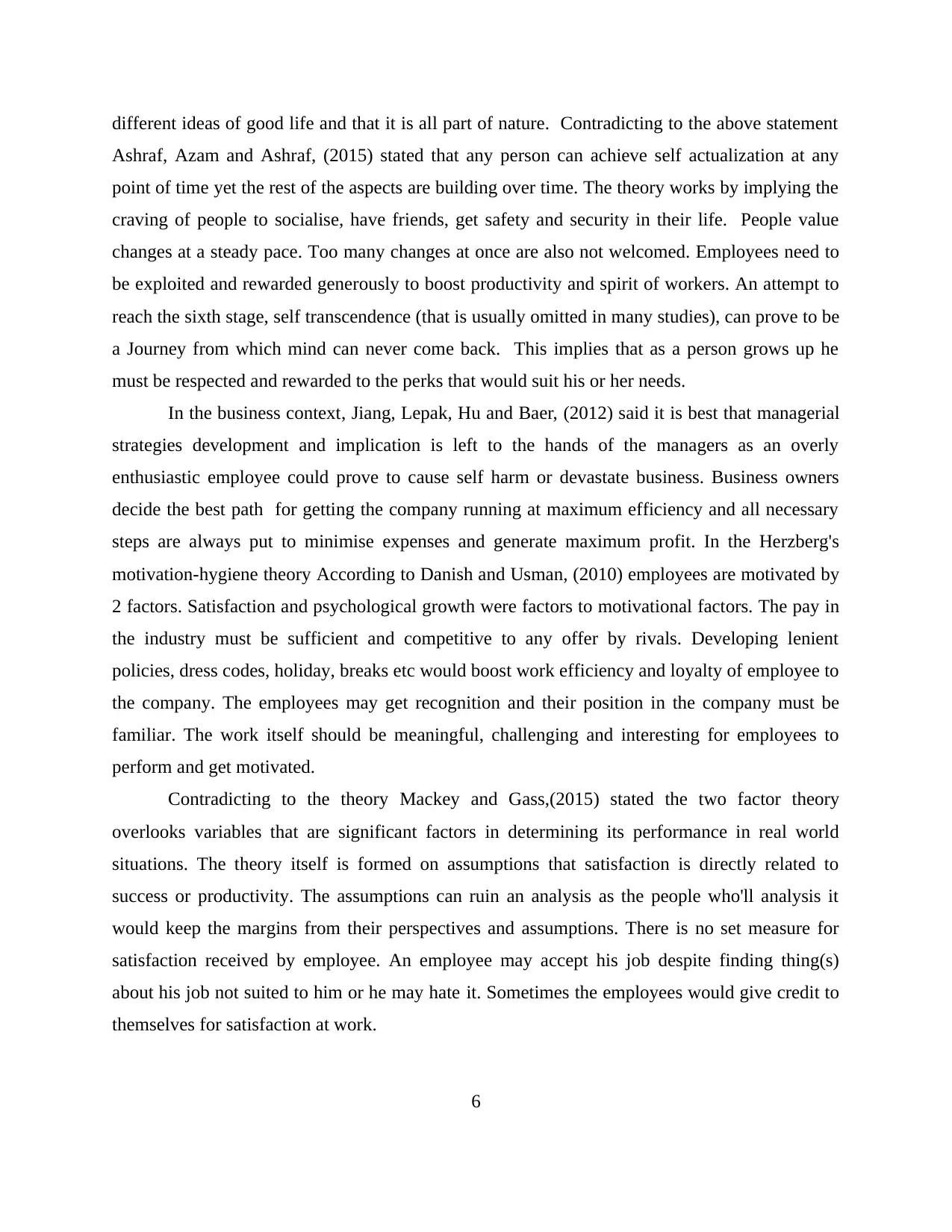
different ideas of good life and that it is all part of nature. Contradicting to the above statement
Ashraf, Azam and Ashraf, (2015) stated that any person can achieve self actualization at any
point of time yet the rest of the aspects are building over time. The theory works by implying the
craving of people to socialise, have friends, get safety and security in their life. People value
changes at a steady pace. Too many changes at once are also not welcomed. Employees need to
be exploited and rewarded generously to boost productivity and spirit of workers. An attempt to
reach the sixth stage, self transcendence (that is usually omitted in many studies), can prove to be
a Journey from which mind can never come back. This implies that as a person grows up he
must be respected and rewarded to the perks that would suit his or her needs.
In the business context, Jiang, Lepak, Hu and Baer, (2012) said it is best that managerial
strategies development and implication is left to the hands of the managers as an overly
enthusiastic employee could prove to cause self harm or devastate business. Business owners
decide the best path for getting the company running at maximum efficiency and all necessary
steps are always put to minimise expenses and generate maximum profit. In the Herzberg's
motivation-hygiene theory According to Danish and Usman, (2010) employees are motivated by
2 factors. Satisfaction and psychological growth were factors to motivational factors. The pay in
the industry must be sufficient and competitive to any offer by rivals. Developing lenient
policies, dress codes, holiday, breaks etc would boost work efficiency and loyalty of employee to
the company. The employees may get recognition and their position in the company must be
familiar. The work itself should be meaningful, challenging and interesting for employees to
perform and get motivated.
Contradicting to the theory Mackey and Gass,(2015) stated the two factor theory
overlooks variables that are significant factors in determining its performance in real world
situations. The theory itself is formed on assumptions that satisfaction is directly related to
success or productivity. The assumptions can ruin an analysis as the people who'll analysis it
would keep the margins from their perspectives and assumptions. There is no set measure for
satisfaction received by employee. An employee may accept his job despite finding thing(s)
about his job not suited to him or he may hate it. Sometimes the employees would give credit to
themselves for satisfaction at work.
6
Ashraf, Azam and Ashraf, (2015) stated that any person can achieve self actualization at any
point of time yet the rest of the aspects are building over time. The theory works by implying the
craving of people to socialise, have friends, get safety and security in their life. People value
changes at a steady pace. Too many changes at once are also not welcomed. Employees need to
be exploited and rewarded generously to boost productivity and spirit of workers. An attempt to
reach the sixth stage, self transcendence (that is usually omitted in many studies), can prove to be
a Journey from which mind can never come back. This implies that as a person grows up he
must be respected and rewarded to the perks that would suit his or her needs.
In the business context, Jiang, Lepak, Hu and Baer, (2012) said it is best that managerial
strategies development and implication is left to the hands of the managers as an overly
enthusiastic employee could prove to cause self harm or devastate business. Business owners
decide the best path for getting the company running at maximum efficiency and all necessary
steps are always put to minimise expenses and generate maximum profit. In the Herzberg's
motivation-hygiene theory According to Danish and Usman, (2010) employees are motivated by
2 factors. Satisfaction and psychological growth were factors to motivational factors. The pay in
the industry must be sufficient and competitive to any offer by rivals. Developing lenient
policies, dress codes, holiday, breaks etc would boost work efficiency and loyalty of employee to
the company. The employees may get recognition and their position in the company must be
familiar. The work itself should be meaningful, challenging and interesting for employees to
perform and get motivated.
Contradicting to the theory Mackey and Gass,(2015) stated the two factor theory
overlooks variables that are significant factors in determining its performance in real world
situations. The theory itself is formed on assumptions that satisfaction is directly related to
success or productivity. The assumptions can ruin an analysis as the people who'll analysis it
would keep the margins from their perspectives and assumptions. There is no set measure for
satisfaction received by employee. An employee may accept his job despite finding thing(s)
about his job not suited to him or he may hate it. Sometimes the employees would give credit to
themselves for satisfaction at work.
6
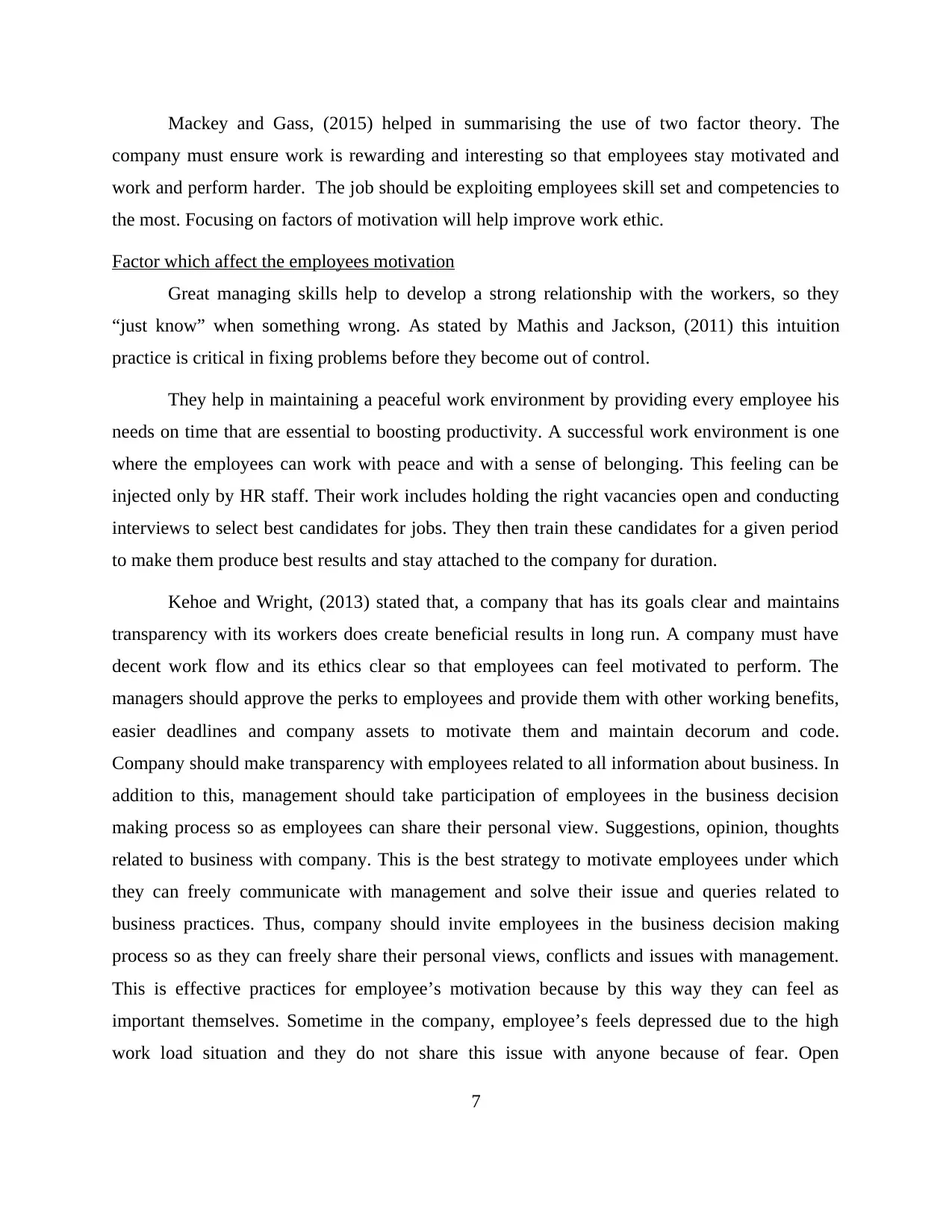
Mackey and Gass, (2015) helped in summarising the use of two factor theory. The
company must ensure work is rewarding and interesting so that employees stay motivated and
work and perform harder. The job should be exploiting employees skill set and competencies to
the most. Focusing on factors of motivation will help improve work ethic.
Factor which affect the employees motivation
Great managing skills help to develop a strong relationship with the workers, so they
“just know” when something wrong. As stated by Mathis and Jackson, (2011) this intuition
practice is critical in fixing problems before they become out of control.
They help in maintaining a peaceful work environment by providing every employee his
needs on time that are essential to boosting productivity. A successful work environment is one
where the employees can work with peace and with a sense of belonging. This feeling can be
injected only by HR staff. Their work includes holding the right vacancies open and conducting
interviews to select best candidates for jobs. They then train these candidates for a given period
to make them produce best results and stay attached to the company for duration.
Kehoe and Wright, (2013) stated that, a company that has its goals clear and maintains
transparency with its workers does create beneficial results in long run. A company must have
decent work flow and its ethics clear so that employees can feel motivated to perform. The
managers should approve the perks to employees and provide them with other working benefits,
easier deadlines and company assets to motivate them and maintain decorum and code.
Company should make transparency with employees related to all information about business. In
addition to this, management should take participation of employees in the business decision
making process so as employees can share their personal view. Suggestions, opinion, thoughts
related to business with company. This is the best strategy to motivate employees under which
they can freely communicate with management and solve their issue and queries related to
business practices. Thus, company should invite employees in the business decision making
process so as they can freely share their personal views, conflicts and issues with management.
This is effective practices for employee’s motivation because by this way they can feel as
important themselves. Sometime in the company, employee’s feels depressed due to the high
work load situation and they do not share this issue with anyone because of fear. Open
7
company must ensure work is rewarding and interesting so that employees stay motivated and
work and perform harder. The job should be exploiting employees skill set and competencies to
the most. Focusing on factors of motivation will help improve work ethic.
Factor which affect the employees motivation
Great managing skills help to develop a strong relationship with the workers, so they
“just know” when something wrong. As stated by Mathis and Jackson, (2011) this intuition
practice is critical in fixing problems before they become out of control.
They help in maintaining a peaceful work environment by providing every employee his
needs on time that are essential to boosting productivity. A successful work environment is one
where the employees can work with peace and with a sense of belonging. This feeling can be
injected only by HR staff. Their work includes holding the right vacancies open and conducting
interviews to select best candidates for jobs. They then train these candidates for a given period
to make them produce best results and stay attached to the company for duration.
Kehoe and Wright, (2013) stated that, a company that has its goals clear and maintains
transparency with its workers does create beneficial results in long run. A company must have
decent work flow and its ethics clear so that employees can feel motivated to perform. The
managers should approve the perks to employees and provide them with other working benefits,
easier deadlines and company assets to motivate them and maintain decorum and code.
Company should make transparency with employees related to all information about business. In
addition to this, management should take participation of employees in the business decision
making process so as employees can share their personal view. Suggestions, opinion, thoughts
related to business with company. This is the best strategy to motivate employees under which
they can freely communicate with management and solve their issue and queries related to
business practices. Thus, company should invite employees in the business decision making
process so as they can freely share their personal views, conflicts and issues with management.
This is effective practices for employee’s motivation because by this way they can feel as
important themselves. Sometime in the company, employee’s feels depressed due to the high
work load situation and they do not share this issue with anyone because of fear. Open
7
⊘ This is a preview!⊘
Do you want full access?
Subscribe today to unlock all pages.

Trusted by 1+ million students worldwide
1 out of 47
Related Documents
Your All-in-One AI-Powered Toolkit for Academic Success.
+13062052269
info@desklib.com
Available 24*7 on WhatsApp / Email
![[object Object]](/_next/static/media/star-bottom.7253800d.svg)
Unlock your academic potential
Copyright © 2020–2025 A2Z Services. All Rights Reserved. Developed and managed by ZUCOL.




